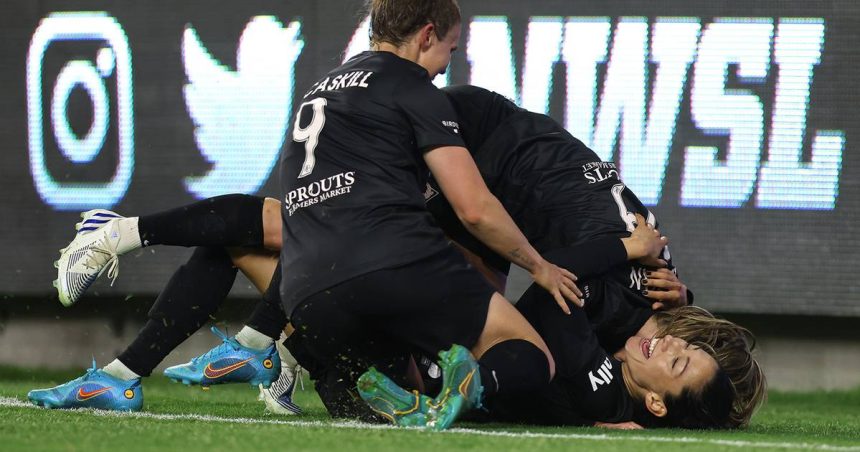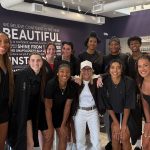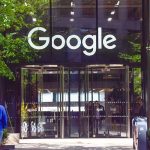With two World Cup wins, an Olympic bronze medal, and experience in multiple pro leagues around the world, Christen Press is one of the most prolific soccer players of the time. But fans would be hard-pressed to find digital evidence of her early career highlights from when she competed in Women’s Professional Soccer (WPS), the precursor to the National Women’s Soccer League (NWSL) that folded in 2012.
“If you go back and try to find highlights from my first years as a pro, you can’t,” Press told Marketing Brew. “You can find US Women’s National Team (USWNT) highlights always, but that’s what you’ll find. It was like that was my only job.”
Now, highlights of Press—or, really, any other pro women’s soccer player—are abundantly available, just one indication of just how much the landscape of women’s sports has shifted in the last few decades. More than 50 years after the passage of Title IX made it possible for more girls to succeed in sports in grade school, the talent pool of women athletes is deeper than ever, media outlets are showing women’s sporting events in prime time to record-breaking audiences, and major brands are funneling sponsorship dollars into the ecosystem.
Sport to sport, it’s not exactly clear what should be credited with kicking off the boom. But does it matter? Thirteen years after the founding of the NWSL, women’s professional soccer seems here to stay in more ways than one, with two of the biggest revenue drivers in sports—media rights and sponsorships—abundant enough to prop up two pro properties.
Ready for prime time
One of the biggest changes in the women’s soccer ecosystem in recent years has been media coverage of the sport. In the days of the WPS, and even more recently, fans often struggled to find games on TV aside from international tournaments like the World Cup and the Olympics every couple of years.
“When I started playing in the WPS and my first days of the NWSL, I was playing in front of a couple hundred people on bleachers in high schools and colleges,” Press remembered.
It wasn’t until 2022 when CBS Sports aired the NWSL Championship in prime time for the first time, but when it did, the game became the most-watched NWSL match in history, with 915,000 viewers, a 71% increase from 2021, per CBS. (The 2024 Championship beat that record, averaging 967,900 viewers, according to the NWSL.)
The deal for prime-time coverage in part came about thanks to Ally Financial, a years-long sponsor of the NWSL and many other women’s sports properties, which played a key role in conversations with the league and the network.
“You’ve got this vicious cycle that’s never going to be broken unless the brands jump in and kind of force systemic change,” Ally CMO Andrea Brimmer told Marketing Brew at the time. “It takes the brands sitting at the table to demonstrate that they’re willing to come in, that they’ve got the money to invest, but that they need the networks to think differently about the way that they’re selling media and the way that they are giving women’s sports timeslots and the platforms that they deserve.”
The NWSL’s current four-year media rights deal, signed in 2023, indicates a much different approach from networks and streamers, spanning coverage across CBS Sports, ESPN, Prime Video, and Scripps Sports; it’s reportedly worth $240 million. As of the mid-point of the current NWSL season, livestreams of matches were up 34% year over year, with 1.2 billion minutes viewed, according to the league. Women’s soccer fans can also watch pros play on Peacock, which holds the media rights to the Gainbridge Super League, a new pro women’s soccer league that kicks off its second season on August 23.
New media
While major media outlets play a big role in whether women’s soccer is widely available to audiences, the ecosystem has also been thriving thanks to athletes taking matters into their own hands, leveraging channels like social media and podcasts to increase visibility of the sport.
“Social media completely changed the landscape for women’s sports in a really powerful way, because before, you had all these legacy media channels that really acted as middlemen,” said Tobin Heath, an NWSL and USWNT icon who announced her retirement in July. “Once a year you’d get this terrible window, never prime time, and always it was through a lens of what the patriarchy wanted to see in women’s sports, which was obviously extremely narrow and really didn’t represent our sport’s culture at all.”
That frustration led Heath and Press, who are married, to found Re—Inc, a sports media company that publishes newsletters and podcasts meant to represent “gal culture,” which Heath described as an answer to “bro culture.” Their podcast, The Re—Cap Show, joined the Audacy network for distribution and global ad sales in July, part of a larger wave of growing interest in women’s sports podcasts.
Get marketing news you’ll actually want to read
Marketing Brew informs marketing pros of the latest on brand strategy, social media, and ad tech via our weekday newsletter, virtual events, marketing conferences, and digital guides.
Heath and Press aren’t the only soccer icons who have carved out their own media channels. Former USWNT co-captain Alex Morgan has Togethxr, the media and commerce company she started with Olympic snowboarder Chloe Kim, Olympic swimmer Simone Manuel, and basketball legend Sue Bird. Bird also founded production company A Touch More alongside her partner, Megan Rapinoe, another retired USWNT co-captain.
Through these platforms, the players can bypass legacy media companies and engage directly with fans on their own terms, which wasn’t always an option for athletes. Brandi Chastain, whose penalty kick delivered the USWNT the World Cup in 1999 and who went on to work with brands including Nike, Gatorade, and Bud Light, said she sometimes thinks about what her sponsorship roster could have looked like had she been playing in 2025.
“In terms of brands and branding, gosh, I think there’s a part of me that wishes that there were all these resources that existed,” she said.
Brand ball
As the audience for women’s soccer has grown, so too has its list of sponsors. This year, the NWSL kicked off its 13th season with 13 sponsors, including first-time brands E.l.f. Beauty and Alex Cooper’s Unwell Hydration. E.l.f.’s involvement represents a broader trend of beauty brands, which haven’t historically invested much in sports, leaning into sports sponsorship opportunities across leagues, including the NFL and WNBA. In August, E.l.f. further upped its investment in women’s soccer by signing NWSL players Melanie Barcenas, Abby Dahlkemper, Lo’eau LaBonta, and Jaedyn Shaw to its talent roster.
For brands, women’s sports are particularly compelling because the audience tends to encompass different consumers than men’s sports audiences, Super League President Amanda Vandervort told Marketing Brew. In pro basketball, for example, only 5% of Golden State Valkyries season-ticket holders also have Warriors season tickets, despite the teams sharing both an arena and a sport, a standout stat for founding partner JPMorganChase.
“There’s so many communities who haven’t had access to women’s pro soccer, and when you add that to the growing interest, the demographics and behaviors of our fans, and the opportunity for brands and sponsors to get in front of a whole new audience, it just makes business sense,” Vandervort said. “Now, we’re having real conversations about the return on the investment in women’s professional soccer.”
This year, the Super League announced Gainbridge had purchased the league’s naming rights, and it’s only seen an uptick in inbound interest since then, according to Vandervort. The league also has several endemic sponsors, including kit provider Capelli Sport and ball manufacturer Select.
In the NWSL, jersey sponsorships are breaking records at breakneck speed. Last year, Bay FC reportedly had the biggest back-of-jersey deal in the league with Trader Joe’s, and in February, Gotham FC and Dove reportedly broke the record again. Days later, the Portland Thorns and Ring were said to have agreed to the biggest deal in league history, exceeding $2.6 million.
“It’s not just about the dollars,” Matt Soloff, SVP, partnerships and business development at the NWSL, told us. “It’s about leaning into brands that want to lean into us at the highest level.”
Amazon, for instance, has a wide-ranging relationship with the NWSL that includes streaming rights to Friday night games and a playoff match on Prime Video, as well as an exclusive retail sponsorship for Amazon and the presenting sponsorship of the league’s Best XI Awards for Amazon Prime. The company also worked with the league and other media partners, including Togethxr, for a docuseries about the 2024 season.
It was the “rabid fanbase and the growth” of the league that made it stand out to a sponsor as big as Amazon, according to Deb Curtis, global director of marketing for Amazon Prime.
“The growth and the excitement around women’s sports, and obviously the NWSL, is incredibly energizing,” Curtis said. “Fandom fuels growth, and so we see our role as being able to go deeper. People know our brand, so how can our brand help to enhance that experience?”
Brand sponsorship dollars can also be invested back into the leagues, creating a virtuous cycle for women’s soccer.
For some players who have seen the industry shift in real time, it feels like vindication.
“What’s been proven is people love women’s sports,” Heath said. “That’s just the truth, and also, they love women’s athletes as people. Brands love women’s athletes. They’re more approachable. They’re better at marketing.”
This is one of the stories of our Quarter Century Project, which highlights the various ways industry has changed over the last 25 years. Check back each month for new pieces in this series and explore our timeline featuring the ongoing series.
Visit the timeline
Read the full article here










